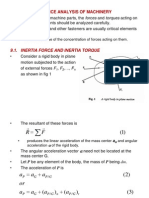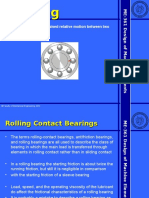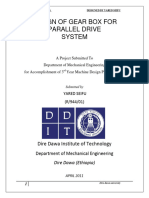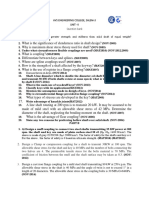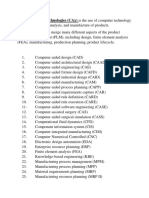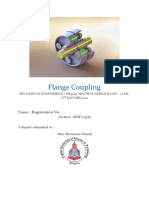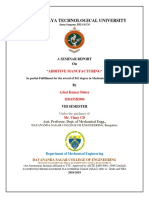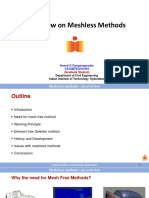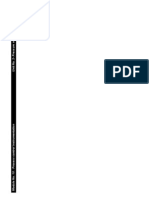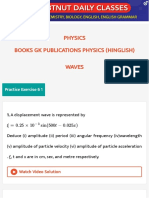0 ratings0% found this document useful (0 votes)
163 viewsFinite Element Analysis of Human Femur Bone
Finite Element Analysis of Human Femur Bone
Uploaded by
Areez Khanthe review of finite element analysis of femur bone
Copyright:
© All Rights Reserved
Available Formats
Download as PPTX, PDF, TXT or read online from Scribd
Finite Element Analysis of Human Femur Bone
Finite Element Analysis of Human Femur Bone
Uploaded by
Areez Khan0 ratings0% found this document useful (0 votes)
163 views14 pagesthe review of finite element analysis of femur bone
Copyright
© © All Rights Reserved
Available Formats
PPTX, PDF, TXT or read online from Scribd
Share this document
Did you find this document useful?
Is this content inappropriate?
the review of finite element analysis of femur bone
Copyright:
© All Rights Reserved
Available Formats
Download as PPTX, PDF, TXT or read online from Scribd
Download as pptx, pdf, or txt
0 ratings0% found this document useful (0 votes)
163 views14 pagesFinite Element Analysis of Human Femur Bone
Finite Element Analysis of Human Femur Bone
Uploaded by
Areez Khanthe review of finite element analysis of femur bone
Copyright:
© All Rights Reserved
Available Formats
Download as PPTX, PDF, TXT or read online from Scribd
Download as pptx, pdf, or txt
You are on page 1of 14
FAZAL ZEHRAN (18957)
AREEZ KHAN (19993)
Femur bone is also known as thigh bone. The femur bone is the longest, heaviest
and strongest bone in the human body. The length of this bone is almost 26% of the
height of person.
Femur bone is divided into three parts: upper extremity, body and lower extremity.
An effort is made to analyse the stresses experienced by the human femur. In order
to achieve these results a CAD model was developed by using the 3-D scanning of
generic human femur for an individual of 70 kg weight (approx. averaged adult
weight). The marrow cavity has been approximated as a hollow cylinder.
In this work, FEA is used to analyse the human femur bone.
Finite element method (FEM) is a technique of solution of the boundary value
problems.
It can be explained as a numerical method for solving differential and integral
equations. Finite element analysis (FEA) is the practical application of FEM.
FEA is a computational tool for carrying out engineering analysis. It can be used
for analysis of new product designs as well as for the existing designs using the
equations of mechanics of materials.
Two different specimens of human femur bones were collected for this study. Given
specimens were from the subjects of around 70 Kg in weight.
3-D laser scanning was performed on available specimens using NextGen® 3D
laser scanner. From this procedure data cloud was obtained which can be imported
in CAD software to obtain the geometric features of a femur bone. Obtained data
cloud is shown in Figure 2.
Femur CAD model was developed in SolidWorks® using the technique of
transforming 2D geometry into 3D
At this stage CAD model was obtained based on external geometric features of
femur bone however, the internal detail (e.g. marrow cavity) in CAD was
approximated.
The dimensions of marrow cavity are hard to know considering it is hallow imprint
within the bone.
The dimensions of marrow cavity were approximated in this work with a hallow
cylinder following the curvature of the bone with spherical ends. The diameter of
marrow cavity was taken as 1.6 cm.
Marrow cavity is hallowing
CAD model of human femur (SolidWorks®) cut curving cylinder of
radius 1.6 cm with spherical
ends
FEA mesh represents the nodes and elements for structural calculations. In this
work, FEA mesh was generated on 3D CAD model of femur bone.
Tetrahedral 20-noded 186 Structural Solid elements were used to build the FEA
mesh
FEA mesh was generated using the auto-mesh generation algorithm in FEA
software ANSYS®
Mesh refinement was performed in desired segments of the bone to avoid
unrealistic stress concentration points. Furthermore mesh was refined in regions of
higher gradients to magnify the accuracy of results. Mesh sensitivity analysis was
also carried out to ensure the quality of results
Two different kind of loading conditions were applied to simulate real case
scenarios.
In first case axial loading (compression) was applied in direction of the bone. This
case simulates the weight handled by femur in upright standing position.
In second case bending load (perpendicular) is applied to femur bone.
In both cases boundary constraint was applied on the other end of the femur bone.
Summary of stresses from axial and bending loadings; * indicates failure
FEA analysis is performed on model of femur bone by varying the loads. The
maximum stresses generated in this analysis are given in Table 1. The failure stress
is taken as 100 MPa based on experimental data available in literature [4]. The
results indicate the failure of femur bone under the loading of 414 Kg of weight
under axial loading and 69 Kg of load under the bending load. The results clearly
indicate that the strength of femur bone in axial direction is significantly more than
compared to bending. The point of high stress is indicated in Figure 7.
Following conclusions can be drawn from FEM analysis of human femur bone:
1 Axial strength of femur is almost six times than bending.
2 Human femur can withstand ten times the load of its body weight.
3 Evaluated results are the indicative of the failure criteria of substitute material
for bones.
4 Given methodology can be used over other biomechanical structures for study
[1] Szabo, B.A. and I. Babuška, Finite Element Analysis 1991: Wiley.
[2] Zienkiewicz, O.C., R.L. Taylor, and J.Z. Zhu, The Finite Element Method: Its Basis and
Fundamentals: Its Basis and Fundamentals 2005: Elsevier Science.
[3] Burstein, A.H., et al., The ultimate properties of bone tissue: The effects of yielding.
Journal of Biomechanics, 1972. 5(1): p. 35–44.
[4] Ji, B. and H. Gao, Mechanical properties of nanostructure of biological materials.
Journal of the Mechanics and Physics of Solids, 2004. 52(9): p. 1963–1990.
[5] Currey, J.D., Mechanical properties of bone tissues with greatly differing functions.
Journal of Biomechanics, 1979. 12(4): p. 313–319.
[6] Currey, J.D., The effect of porosity and mineral content on the Young's modulus of
elasticity of compact bone. Journal of Biomechanics, 1988. 21(2): p. 131–139.
[7] Katz, J.L. and Y. Hyo Sub, The Structure and Anisotropic Mechanical Properties of
Bone. Biomedical Engineering, IEEE Transactions on, 1984. BME-31(12): p. 878–884.
[8] Weiner, S. and H.D. Wagner, THE MATERIAL BONE: Structure-Mechanical Function
Relations. Annual Review of Materials Science, 1998. 28(1): p. 271–298.
[9] Stolarski, T., Y. Nakasone, and S. Yoshimoto, Engineering Analysis with ANSYS
Software 2011: Elsevier Science.
Int. Jnl. of Multiphysics Volume 9 · Number 2 · 2015 107
[10] Papini, M., et al., The biomechanics of human femurs in axial and torsional
loading: comparison of finite element analysis, human cadaveric femurs, and
synthetic femurs. J Biomech Eng, 2007. 129(1): p. 12–9.
[11] Huang, B.W., et al., Dynamic Characteristics of a Hollow Femur. Life Science
Journal, 2012. 9(1): p. 723–726.
[12] ANSYS®, Academic Research, release 12.0.
[13] ANSYS®, Academic Research, Theory Reference, in Structures, Static Analysis
release 12.0.
[14] Systèmes, D., SolidWorks®, release 2012.
[15] Lombard, M., Solidworks 2013 Bible 2013: Wiley.
You might also like
- Productivity and Reliability-Based Maintenance Management, Second EditionFrom EverandProductivity and Reliability-Based Maintenance Management, Second EditionNo ratings yet
- Spinner SondexDocument24 pagesSpinner Sondexu200626291875% (4)
- Topology Optimization of A Jet Engine Bracket Using SolidworksDocument46 pagesTopology Optimization of A Jet Engine Bracket Using SolidworksAhmedNo ratings yet
- Finite Element Analysis of Human RIB CagDocument4 pagesFinite Element Analysis of Human RIB CagSubramani KarurNo ratings yet
- FINEMarine FAQDocument62 pagesFINEMarine FAQAnson Novendra100% (1)
- Design and Fabrication of Cycloidal Gear Box: A Project Report OnDocument25 pagesDesign and Fabrication of Cycloidal Gear Box: A Project Report OnAjay NishadNo ratings yet
- Design of Lightweight Disc Brake Using Finite Element Analysis and Taguschi TechniqueDocument11 pagesDesign of Lightweight Disc Brake Using Finite Element Analysis and Taguschi Techniquerudey18No ratings yet
- Kinematics and Dynamics - Lab3 PDFDocument8 pagesKinematics and Dynamics - Lab3 PDFKunal SharmaNo ratings yet
- P6 Presentation-30-3-2021Document68 pagesP6 Presentation-30-3-2021Moiz MalikNo ratings yet
- Electron Beam MachiningDocument30 pagesElectron Beam Machiningmehedi hasanNo ratings yet
- Self Healing RobotsDocument23 pagesSelf Healing Robots1da09ec064No ratings yet
- Force Analysis of Machinery: 9.1. Inertia Force and Inertia TorqueDocument16 pagesForce Analysis of Machinery: 9.1. Inertia Force and Inertia TorqueaddisudagneNo ratings yet
- Chain Less BicycleDocument46 pagesChain Less BicycleShubham PatilNo ratings yet
- STAIR Climber Project ReportDocument40 pagesSTAIR Climber Project ReportThakur Ritik singhNo ratings yet
- Cama Lab1Document63 pagesCama Lab1pachieduNo ratings yet
- BearingsDocument26 pagesBearingsAHMED ALZAHRANINo ratings yet
- Models - Mbd.washing Machine Vibration PDFDocument36 pagesModels - Mbd.washing Machine Vibration PDFgf-antaresNo ratings yet
- 06 Question Bank MV 2018 Unit V Vibration Measurement PDFDocument1 page06 Question Bank MV 2018 Unit V Vibration Measurement PDFNABIL HUSSAINNo ratings yet
- Electrochemical TurningDocument3 pagesElectrochemical Turningurnoor67% (3)
- Motorized Smart Turning MechanismDocument3 pagesMotorized Smart Turning MechanismSUMEET SINGHNo ratings yet
- Technical Seminar Presentation HarishDocument21 pagesTechnical Seminar Presentation Harishprashanth nNo ratings yet
- Kinematic Analysis of McPhersonDocument7 pagesKinematic Analysis of McPhersonznamNo ratings yet
- Project 1 PDFDocument70 pagesProject 1 PDFBrian Freeman100% (3)
- Robotics & AutomationDocument20 pagesRobotics & AutomationHans wilsonNo ratings yet
- Yared Love Gear Box DesignDocument117 pagesYared Love Gear Box DesignYigremachew bizualew AyenewNo ratings yet
- Yt Yc 2 Ut 2Document2 pagesYt Yc 2 Ut 2ManivannanNo ratings yet
- FEA Lab Manual PDFDocument49 pagesFEA Lab Manual PDFAdithya KashyapNo ratings yet
- 3 Design and Analysis of Gearless TransmissionDocument68 pages3 Design and Analysis of Gearless TransmissionRåjêßh M Ińtü100% (2)
- Unit-2 - Representation of Curve and SurfacesDocument45 pagesUnit-2 - Representation of Curve and SurfacesSreehari Nambiar KTNo ratings yet
- Sathyabama Question PaperDocument3 pagesSathyabama Question PaperamiestudentNo ratings yet
- PCET-NMIET Department of Mechanical EngineeringDocument69 pagesPCET-NMIET Department of Mechanical Engineeringnikhil pandkarNo ratings yet
- Unit 2 PPT DOM 3.9.21Document27 pagesUnit 2 PPT DOM 3.9.21MURALI KRISHNAN RNo ratings yet
- Modeling and Simulation Study of BAJA SAEINDIA All Terrain Vehicle (ATV) Using Integrated MBD-FEA ApproachDocument15 pagesModeling and Simulation Study of BAJA SAEINDIA All Terrain Vehicle (ATV) Using Integrated MBD-FEA ApproachRohit RajNo ratings yet
- Me8793 Ppce Unit IVDocument54 pagesMe8793 Ppce Unit IVjeevan ram vNo ratings yet
- Computer Aided Technologies Part - 1Document18 pagesComputer Aided Technologies Part - 1Swarn KumarNo ratings yet
- 53106-mt - Mechanics of Composite MaterialsDocument2 pages53106-mt - Mechanics of Composite MaterialsSRINIVASA RAO GANTANo ratings yet
- Study On The Performance of Electroless Nickel Coating On Aluminium For Cylinder LinersDocument8 pagesStudy On The Performance of Electroless Nickel Coating On Aluminium For Cylinder LinersBharat Vinjamuri100% (1)
- Me III II DMM II LnotesDocument33 pagesMe III II DMM II LnotesChandu MallamNo ratings yet
- Vibration LabDocument38 pagesVibration Labtinkusk24No ratings yet
- Robot Gripper YashvantPatelDocument35 pagesRobot Gripper YashvantPatelyash523100% (1)
- Head Gestured Automated Wheelchair: Bachelor of Technology Department of MECHANICAL EngineeringDocument42 pagesHead Gestured Automated Wheelchair: Bachelor of Technology Department of MECHANICAL EngineeringNimitesh SinghNo ratings yet
- Machine Design Project Lecture - 2Document115 pagesMachine Design Project Lecture - 2Hinsermu NeftalemNo ratings yet
- Me6503 Dme Unit 2 Study Notes 2015Document27 pagesMe6503 Dme Unit 2 Study Notes 2015Bala MuruganNo ratings yet
- CAD CAM Unit - 3 PPT-ilovepdf-compressedDocument66 pagesCAD CAM Unit - 3 PPT-ilovepdf-compressedTaha SakriwalaNo ratings yet
- IJREI - Vibration Analysis and Response Characteristics of A Half Car Model Subjected To Different Sinusoidal Road ExcitationDocument6 pagesIJREI - Vibration Analysis and Response Characteristics of A Half Car Model Subjected To Different Sinusoidal Road ExcitationIjrei JournalNo ratings yet
- Self Centering Four Jaw ChuckDocument6 pagesSelf Centering Four Jaw ChuckbalakaleesNo ratings yet
- Chapter 13 - Non Linear Analysis PDFDocument20 pagesChapter 13 - Non Linear Analysis PDFdeepakNo ratings yet
- Design and Fabrication of A GripperDocument8 pagesDesign and Fabrication of A Gripperengr_faheemNo ratings yet
- r05320305 Design of Machine Members IIDocument11 pagesr05320305 Design of Machine Members IISrinivasa Rao G100% (4)
- Finite Element Model Question PaperDocument4 pagesFinite Element Model Question PaperSrinivasan SriniNo ratings yet
- Presentation On Wire EdmDocument33 pagesPresentation On Wire EdmArpit HalaniNo ratings yet
- Training Manual: I D I Ansys Introduction To ANSYSDocument6 pagesTraining Manual: I D I Ansys Introduction To ANSYSLUISALBERTO06011985No ratings yet
- Flange Coupling Lab PDFDocument25 pagesFlange Coupling Lab PDFAli Raza MalikNo ratings yet
- Additive Manufacturing-Achal DubeyDocument25 pagesAdditive Manufacturing-Achal DubeyAchal Kumar DubeyNo ratings yet
- FDP Brochure-3D PrintingDocument2 pagesFDP Brochure-3D Printingravi_2008No ratings yet
- Classical Kinematis CHP 1-14Document95 pagesClassical Kinematis CHP 1-14kullayot suwantarojNo ratings yet
- Presentation On Construction and Details of GearsDocument13 pagesPresentation On Construction and Details of GearsAjay SheteNo ratings yet
- ChassisDocument42 pagesChassissarvenderrawat100% (1)
- Cams: - Stationary - Translate, or - Rotate - Translate, or - RotateDocument64 pagesCams: - Stationary - Translate, or - Rotate - Translate, or - Rotateaddisudagne50% (2)
- Overview On Meshless Methods: Department of Civil Engineering Indian Institute of Technology HyderabadDocument17 pagesOverview On Meshless Methods: Department of Civil Engineering Indian Institute of Technology Hyderabadsriharsha100% (1)
- Damage Mechanics in Metal Forming: Advanced Modeling and Numerical SimulationFrom EverandDamage Mechanics in Metal Forming: Advanced Modeling and Numerical SimulationRating: 4 out of 5 stars4/5 (1)
- Finite Element Analysis of Human Femur Bone: Uzair N. Mughal, Hassan A. Khawaja and M. MoatamediDocument8 pagesFinite Element Analysis of Human Femur Bone: Uzair N. Mughal, Hassan A. Khawaja and M. MoatamediAreez KhanNo ratings yet
- Finite Element Analysis of Human Femur Bone: Uzair N. Mughal, Hassan A. Khawaja and M. MoatamediDocument8 pagesFinite Element Analysis of Human Femur Bone: Uzair N. Mughal, Hassan A. Khawaja and M. MoatamediAreez KhanNo ratings yet
- Name: Areez Khan SAP ID: 2858 Submitted To: Sir Faheem: Assignment AnatomyDocument2 pagesName: Areez Khan SAP ID: 2858 Submitted To: Sir Faheem: Assignment AnatomyAreez KhanNo ratings yet
- Pakistan Study AssignmentDocument7 pagesPakistan Study AssignmentAreez KhanNo ratings yet
- Transfer Function Zero Pole GainDocument12 pagesTransfer Function Zero Pole GainAreez KhanNo ratings yet
- Centrifugation: Mohammad Areez Khan CMS: 19993Document7 pagesCentrifugation: Mohammad Areez Khan CMS: 19993Areez KhanNo ratings yet
- Unit 2 Pressure MeasurementDocument33 pagesUnit 2 Pressure MeasurementkhalimnNo ratings yet
- Energy Harvesting Using Piezoelectric MaterialsDocument11 pagesEnergy Harvesting Using Piezoelectric Materialsانجینئر بلاول شمیرNo ratings yet
- Lesson Plan Week 4 Atomic TheoryDocument14 pagesLesson Plan Week 4 Atomic TheoryGenesis PalangiNo ratings yet
- Angular QuantitiesDocument17 pagesAngular QuantitiesYu ErinNo ratings yet
- Motion in A Straight Line: Imp. September - 2012Document3 pagesMotion in A Straight Line: Imp. September - 2012nitin finoldNo ratings yet
- Class 11 Physics Book 1 Important DerivationDocument34 pagesClass 11 Physics Book 1 Important DerivationVaibhav YadavNo ratings yet
- By Ian StewartDocument1 pageBy Ian Stewartapi-26217250No ratings yet
- Astm d638 99 CompressDocument7 pagesAstm d638 99 CompressJonel UrbonaNo ratings yet
- Distribution Transformer TestingDocument52 pagesDistribution Transformer TestingVIKRAM DESAI100% (2)
- Generator Perkins - Uk PDFDocument30 pagesGenerator Perkins - Uk PDFAnggaNo ratings yet
- Natural and Forced Convection ExperimentsDocument12 pagesNatural and Forced Convection ExperimentsOmar Yamil Sanchez Torres25% (4)
- GR 8 NS2020 FinalDocument9 pagesGR 8 NS2020 FinalWITNESS NIKEZIWE MATHENJWA0% (1)
- Design Optimization of A Micro Vortex Diode: Kamran Fouladi, PH.D., P.E. Justin Czupryna Widener UniversityDocument19 pagesDesign Optimization of A Micro Vortex Diode: Kamran Fouladi, PH.D., P.E. Justin Czupryna Widener UniversityKamran FouladiNo ratings yet
- Raypa Viscosimetros PDFDocument5 pagesRaypa Viscosimetros PDFFajar AbhiramaNo ratings yet
- HW021-350-E-PR-DS-002 Instrument Process Datasheet - Rev CDocument42 pagesHW021-350-E-PR-DS-002 Instrument Process Datasheet - Rev CSumantra ChattopadhyayNo ratings yet
- Physics Lab 01: Balloons and Static ElectricityDocument4 pagesPhysics Lab 01: Balloons and Static ElectricityHamza QureshiNo ratings yet
- ch12 Electrical PDFDocument71 pagesch12 Electrical PDFYusuf Ilham KholiqNo ratings yet
- 20 The Temperature of An Ideal Gas Remains Constant While The Absolute Pressure Changes From 103Document5 pages20 The Temperature of An Ideal Gas Remains Constant While The Absolute Pressure Changes From 103Aproski tadaNo ratings yet
- 0 Degree Coverage For SS - FilesDocument4 pages0 Degree Coverage For SS - FilessnndhkNo ratings yet
- Mechanism and Robot Kinematics: Anirvan DasguptaDocument122 pagesMechanism and Robot Kinematics: Anirvan Dasguptaसुमित शर्माNo ratings yet
- Fluid Mechanics Course OutlineDocument3 pagesFluid Mechanics Course Outlinemeku44No ratings yet
- Optimal Control of Double Inverted Pendulum Using LQR ControllerDocument4 pagesOptimal Control of Double Inverted Pendulum Using LQR ControllerSachin SharmaNo ratings yet
- Circuit Elements (I) - Resistors (Linear) Ohm's Law Open and ShortDocument33 pagesCircuit Elements (I) - Resistors (Linear) Ohm's Law Open and ShortMichaelNo ratings yet
- Base Plate CalculationDocument8 pagesBase Plate Calculationanbuaed100% (1)
- Revised Syllabus: M. Tech. (Energy Sciences)Document39 pagesRevised Syllabus: M. Tech. (Energy Sciences)TalibNo ratings yet
- Lesson Plan Ces422 PDFDocument2 pagesLesson Plan Ces422 PDFdzikrydsNo ratings yet
- P 660Document98 pagesP 660LouisNo ratings yet
- Books Doubtnut Question BankDocument285 pagesBooks Doubtnut Question Bankrohan sinhaNo ratings yet











